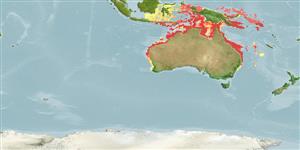Пластиножаберные (акулы и скаты) (sharks and rays) >
Orectolobiformes (Carpet sharks) >
Hemiscylliidae (Bamboo sharks)
Etymology: Hemiscyllium: hemi-, from hemisys (Gr.), half, presumably referring to similarity and/ or close affinity to Scyllium (=Scyliorhinus, now in Scyliorhinidae) and/or Chiloscyllium; skylion, Greek for dogfish or small shark (See ETYFish); ocellatum: Latin for eyed, referring to conspicuous white-ringed black ocellus on flanks above pectoral fins (See ETYFish).
More on author: Bonnaterre.
Environment: milieu / climate zone / depth range / distribution range
экология
морской ассоциированный с рифами; пределы глубины 0 - 50 m (Ref. 54540). Tropical; 1°S - 34°S, 112°E - 163°E (Ref. 54540)
Western Pacific: New Guinea and northern Australia. Possibly occurring in Malaysia, Sumatra (Indonesia), and the Solomon Islands.
Length at first maturity / Size / Вес / Возраст
Maturity: Lm ?, range 60 - ? cm
Max length : 107 cm TL самец/пол неопределен; (Ref. 247)
колючие лучи спинного плавника (общее число) : 0; колючие лучи анального плавника: 0. Caudal fin with a pronounced subterminal notch but without a ventral lobe (Ref. 13575). Lateral ocellus not surrounded by large spots; spots present on head in front and below eyes (Ref. 13575).
Commonly found in shallow water of coral reefs (Ref. 6871). Often in tide pools (Ref. 13575). Feeds mainly on benthic invertebrates (Ref. 6871). Oviparous (Ref. 50449). Squirms when captured but cannot readily escape (Ref. 247). Survives well in aquariums (Ref. 6871). Has the ability to survive low oxygen conditions by switching of non-essential brain functions; apparently an adaption for hunting in tide-pools with low oxygen (Ref. 52022).
Life cycle and mating behavior
половая зрелость | размножение | нерест | икра | Fecundity | личинки
Oviparous, paired eggs are laid. Embryos feed solely on yolk (Ref. 50449). Prior to copulation, the male gets a good grasp of the female by by biting the body and even the gills (Ref. 49562, 51043).
Compagno, L.J.V., 1984. FAO Species Catalogue. Vol. 4. Sharks of the world. An annotated and illustrated catalogue of shark species known to date. Part 1 - Hexanchiformes to Lamniformes. FAO Fish. Synop. 125(4/1):1-249. Rome, FAO. (Ref. 247)
Статус Красного Списка МСОП (Ref. 130435: Version 2024-1)
Использование человеком
рыболовство: интереса не представляет
дополнительная информация
инструменты
Специальные отчеты
Скачать в формате XML
ресурсы в Интернет
Estimates based on models
Preferred temperature (Ref.
123201): 24.1 - 28, mean 26.9 °C (based on 262 cells).
Phylogenetic diversity index (Ref.
82804): PD
50 = 0.5020 [Uniqueness, from 0.5 = low to 2.0 = high].
Bayesian length-weight: a=0.00398 (0.00176 - 0.00901), b=3.09 (2.89 - 3.29), in cm total length, based on LWR estimates for this (Sub)family-body shape (Ref.
93245).
Trophic level (Ref.
69278): 3.4 ±0.2 se; based on diet studies.
устойчивость к внешним воздействиям (Ref.
120179): низкий, минимальное время удвоения популяции 4.5-14 лет (Fec assumed to be <100).
Fishing Vulnerability (Ref.
59153): High vulnerability (64 of 100).
Nutrients (Ref.
124155): Calcium = 13.8 [2.7, 51.9] mg/100g; Iron = 0.395 [0.094, 1.067] mg/100g; Protein = 19.3 [17.1, 21.3] %; Omega3 = 0.0792 [, ] g/100g; Selenium = 30.9 [9.5, 86.3] μg/100g; VitaminA = 44.7 [15.7, 118.8] μg/100g; Zinc = 0.923 [0.453, 1.889] mg/100g (wet weight);
